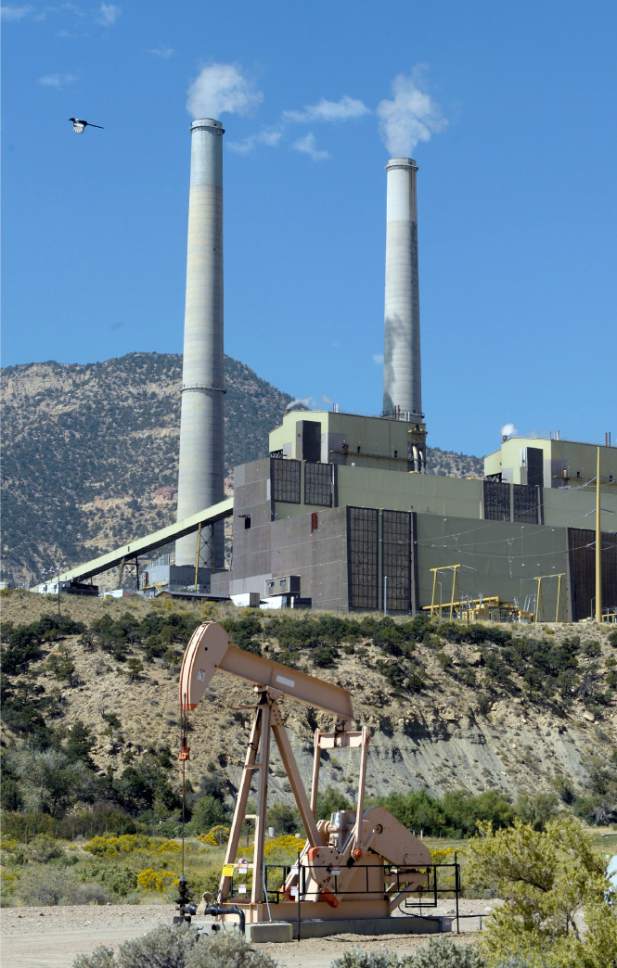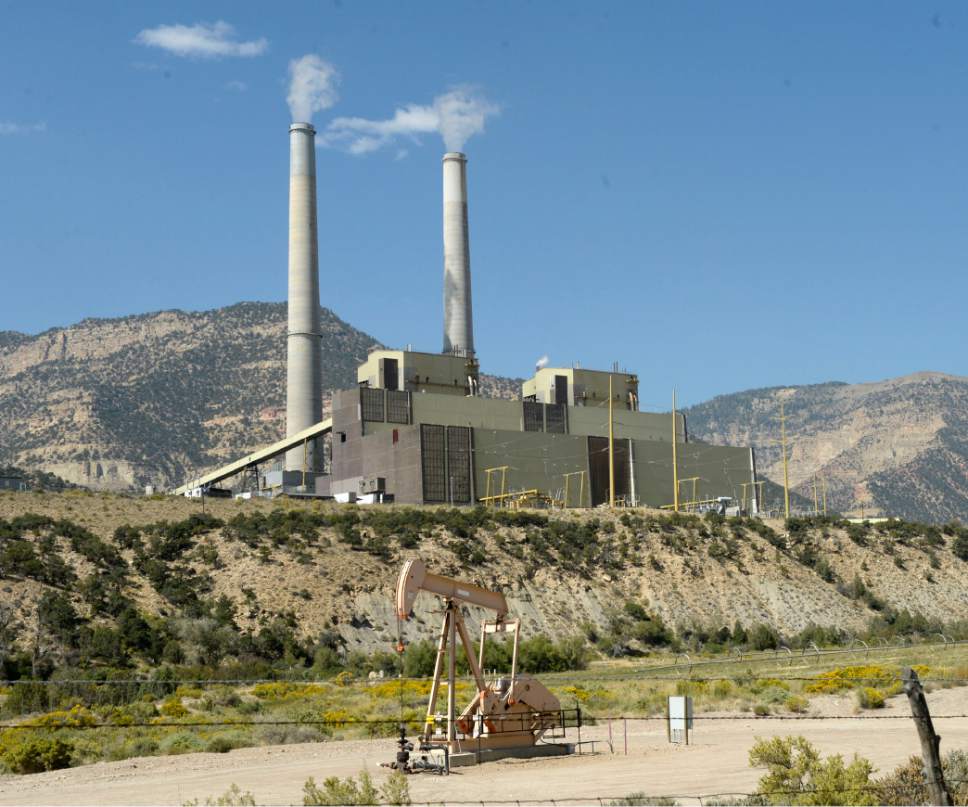This is an archived article that was published on sltrib.com in 2016, and information in the article may be outdated. It is provided only for personal research purposes and may not be reprinted.
After years of delay, the Environmental Protection Agency has decided to require two coal-fired power plants in Utah to install additional pollution controls to improve visibility at nearby national parks.
Utah must be in compliance with the federal plan within five years of the EPA's Wednesday decision — but that may not be the final word on the matter. Rocky Mountain Power, which owns the power plants in question, is weighing legal options. And the state asserts that its own plan is less costly and still capable of achieving the goals of the Regional Haze Rule, a federal regulation that mandates the restoration of "natural" air conditions in 156 national parks and wilderness areas by 2064.
The state-drafted plan credited the April 2015 closure of the utility's central Utah Carbon plant for lowering the state's emissions. The EPA officially rejected that part of the plan and ordered that selective catalytic reduction be installed at Rocky Mountain Power's two remaining coal-fired power plants in Emery County.
The EPA estimates that those pollution controls will reduce emissions of nitrogen oxide, one of the chemicals that contribute to the formation of haze, by nearly 10,000 tons per year.
"EPA is taking action to cut harmful haze pollution at some of our nation's most treasured and popular national parks," Shaun McGrath, EPA Region 8 administrator, said in a news release. "The steps included in this plan will rely on proven, widely used pollution control strategies used at power plants across the country, protect public health, and improve visibility for those who visit our western parks for years to come."
Air pollution from Rocky Mountain Power's Hunter and Huntington plants is believed to contribute to haze formation in eight Southwestern national parks, including Utah's Mighty Five, the Grand Canyon, Mesa Verde and Black Canyon.
"They're the real winners," said Cory MacNulty, a program manager for the Southwest regional office of the National Parks Conservation Association (NPCA). "The parks, the visitors — every person who comes to a national park once the air is cleaner."
Despite the threat of litigation, MacNulty and other environmentalists heralded Wednesday's announcement as a long-sought victory.
"It really has been a long and challenging battle with a lot of iterations," she said, "and we're just really excited that the EPA listened."
"Pollution knows no boundaries, as we've seen in Arizona and our outdoor-industry colleagues have seen in Utah and Colorado," Danny Giovale, founder and president of Kahtoola, a Flagstaff, Ariz.-based manufacturer of outdoors equipment, said in a statement. "By cleaning up these dangerous emissions, the EPA is creating a healthier future for Western families and businesses."
Utah officials, however, have said the EPA's plan is unnecessary and potentially costly to Utah's Rocky Mountain Power customers. The state plan complies with EPA requirements and puts Utah on track with the federal timeline for reducing haze-forming pollutants in nearby national parks, they say, and the additional emissions reductions mandated by the EPA's plan would do little more to improve visibility in the region, where other factors contribute to the formation of haze.
According to the EPA, the federal plan will improve visibility by more than three deciviews at Canyonlands National Park, the area most affected by pollution from the Hunter, which is in Castle Dale, and Huntington plants. A deciview is equal to an incremental change in visibility as perceived by the human eye, according to the EPA.
Bryce Bird, director of the Utah Division of Air Quality, said while the DAQ has yet to decide how it will proceed, the EPA's decisions regarding states' regional haze plans have a history of inspiring legal action.
"The Utah Department of Environmental Quality shares the goal of improved visibility in our national parks and will continue to work toward that end," Bird said in a statement. "We are, however, disappointed with the decision because the Utah plan relied on sound science and common sense, improving visibility at a reasonable cost to Utah ratepayers. We will review the decision in greater detail and meet with key stakeholders before deciding our next steps."
Rocky Mountain Power likewise is "evaluating all legal options in the best interest of our customers," said spokesman Dave Eskelsen.
Though Wednesday's decision primarily concerns a dispute between the EPA and the state, Eskelsen said Rocky Mountain Power would have standing to sue because the utility would incur significant costs — company estimates suggest as much as $700 million — were it required to comply with the EPA's decision.
Rocky Mountain Power has long sided with the state's plan, pointing to state-led research that suggests selective catalytic reduction would not improve visibility in the Southwest, on account of the area's unique air chemistry.
MacNulty, of the parks conservation group, said she was confident the EPA's decision would prove defensible if either entity sues. But it would be ideal, she said, if the state and Rocky Mountain Power would put this issue to rest in light of more upcoming deadlines tied to the Regional Haze Rule.
"It would be really great if we could close this chapter," she said. "This is just the first step."
The Regional Haze Rule was originally designed to be implemented in phases, with states designing increasingly strict implementation plans every 10 years. Wednesday's decision applies to Utah's first plan, which was due in 2008. The next should be due in 2018, though the EPA has proposed an amendment to the Regional Haze Rule that would postpone that deadline.
The NPCA is fighting that delay, MacNulty said.
"The first plan, just look how many years it has taken," she said. "We need to see these plans as soon as possible. We can't delay starting the next plan."
The EPA agreed to finalize its review of Utah's plan to implement the Regional Haze Rule after environmental advocacy groups filed suit against the agency last year.
The agency had rejected Utah's implementation plan for the Regional Haze Rule in October 2012 because the plan did not have an acceptable analysis of new retrofit technologies that could reduce pollution at the Hunter and Huntington plants.
Under the Clean Air Act, the EPA is required to implement a federal haze plan within two years of rejecting a state's plan if the state does not supply an acceptable plan.
A coalition of environmental groups including the Sierra Club, HEAL Utah and the NPCA sued in July after the EPA did not meet the 2014 deadline. After a legal settlement, the EPA in December asked the public for input on two possible courses of action — approving the state's plan entirely or rejecting portions of the plan and replacing them with the federal plan for pollution control at Hunter and Huntington.
The EPA chose the latter after reviewing visibility benefits, cost estimates, feedback received at a well-attended public hearing in January and nearly 5,000 additional comments received electronically, according to agency spokesman Richard Mylott.
Twitter: @EmaPen





